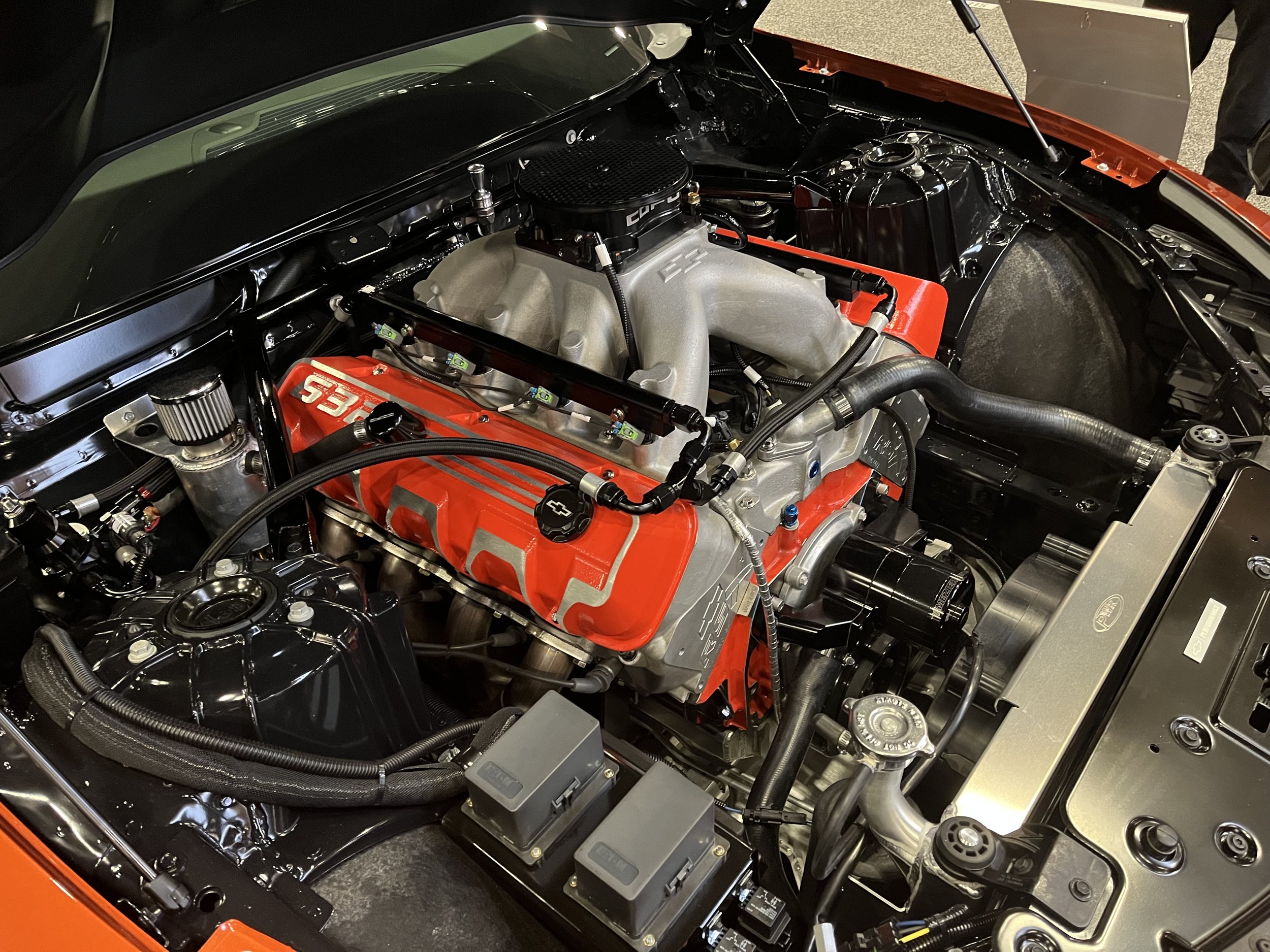It’s Great Straight From the Crate – Reviewing Engine Choices Directly from Ford, Chevrolet and Mopar
Although there are hundreds of reputable engine builders, unless you are aiming for a restricted racing class or have specific needs, crate engines are a great choice for a street or strip build.
The costs are normally lower than what it would cost to duplicate the build with an engine shop, and in most cases, a crate engine will include a warranty. Several dozen businesses offer crate engines, but for in this article, we are going to review the offerings from Ford, Mopar and Chevrolet direct from the manufacturers.
From hoodies to t-shirts, parachute tags and hats, to the full line-up of Sick BBQ spices and sauces, get all the latest and greatest Sick the Magazine merchandise RIGHT HERE!!
Mopar
The offerings direct from Mopar surround the Gen 3 engine platform, and start with an assortment of long block offerings (block with rotating assembly and cylinder heads).
From a basic 345 cubic inch long block sporting 383 horsepower and priced just under $4,500, to the 1,000-plus capable ‘Hellephant’ long block priced at about $19,000, Mopar has both the factory replacement market covered for most offerings, as well as those that want to swap in a modern engine into a classic or street rod.
The same long blocks are also available as a complete engine, and Mopar has one more trick up its sleeve: a new Direct Connection DSR 1500 HEMI engine is association with DSR (Don Schumacher Racing).
The 7-liter 426 cubic inch bullet features some of the best parts in the rotating assembly, including a billet crankshaft, forged I-beam connecting rods and billet pistons.
A pair of ported HEMI Cylinder heads are topped with a Whipple Gen 5 3-liter supercharger that’s ported as well. Boasting 1,500 horsepower and over 1,000 lb.-ft of torque, it’s a powerful choice for a Mopar enthusiast.
Ford
The Blue Oval offers a bit more when it comes to crate engines, with the choices including both modern and classic 8-cylinder offerings, several Coyote engine choices, the relatively new Godzilla 7.3-liter engine, and even an EcoBoost 4-cylinder.
The classic 302 cubic inch and 351 cubic inch based Windsor engines are available in seven different long block set-ups, with four more available with intake and distributor.
Ford does offer one complete 347 cubic inch stroker engine, based on the BOSS 302 block and their new X2 aluminum cylinder head with a Scat rotating assembly and 360 horse power on tap.
The Coyote platform has a couple different complete engine options available, from complete drop-in replacements for Mustang GT and Shelby models, as well as a sealed crate engine designed for use in the National Mustang Racers Association (NMRA) Coyote Stock class.
This 460 horsepower engine gets a spec tuner, and in a competitive 3000-pound car, will run 9.6-second time on a 9-inch rear tire. Besides the factory-supercharged 5.2-liter engine with 760 horsepower, the engine that caught our eye is the boost-ready 5-liter Coyote.
Dropping the compression ratio from 12:1 to 9.5:1, the Coyote packs Mahle forged pistons, Manley H-beam rods, and billet oil pump gears. All it needs is your power-adder of choice and a rolling chassis to drop it into.
Moving to the bigger cubic inch choices, Ford offers a pair of 572 cubic inch big block complete engines, with the choice of a front or rear sump oil pan available. Packing 655 horsepower and 710 lb.-ft of torque, it’s an easy choice for almost any vehicle.
But it’s hard to ignore the Godzilla, the 7.3-liter engine that first saw use in the 2020 Super Duty trucks.
Now available as a crate engine with 430 horsepower and 475 lb.-ft of torque as delivered, the Godzilla engines have already seen 8 and 9-second time slips with boost on board, with Cleetus McFarland pushing the platform to low 8-second times in their ‘McFlurry’ street-legal Fox Mustang.
Chevrolet
The largest crate engine program comes from Chevrolet, with north of 50 offerings in a wide variety of choices. With several options from the gen one small block engine family, Chevrolet also has over a dozen varieties of the LS and LT modern small block platform, as well as big block engines and the popular E-ROD platform that allows for 50 state smog-legal installation in 1995 and earlier vehicles.
They also offer a ‘Connect & Cruise’ package for several engines, with both manual and automatic transmission options to create an easier package to install and get on the street and track with your rolling chassis.
Starting in the old school gen one small block arena, Chevrolet has several choices in the 350 cubic inch-based platform, from long block options to completely dressed crate engines, including front accessories like an alternator, power steering, air-conditioning and a full bracket system.
Some are also available with the choice of EFI or a carburetor for fueling. One of their most popular small block crate engines is the ZZ6, rated from 405 to 420 horsepower depending on the choice of EFI or carburetor.
On the big block side of things, plenty of options exist here as well, from the workhorse 454 cubic inch and 502 cubic inch offerings that have been available for a while, to the proper muscle car offering 427 cubic inch version, packing 480 horsepower and 490 lb.-ft of torque.
But you can’t ignore the bigger power options Chevrolet has, including a 572 cubic inch in two forms. The pump gas ready 9.6:1 compression provides 620 horsepower and 645 lb.-ft of torque, while the race gas required 12:1 compression ratio puts out 720 horsepower and 680 lb.-ft of torque.
Chevrolet’s newest big block offering, which was promoted at the 2022 PRI show, is the 1000 horsepower ZZ632 monster! Sporting an actual 1004 ponies and 876 lb.-ft of torque, it comes set up for fuel injection using a 4500-series throttle body. This engine even became an option for a COPO Camaro race car!
Chevrolet offers a trio of engines in their E-ROD program, including one from the LS platform, a naturally aspirated version of the LS3 engine that makes 430 horsepower and 425 lb.-ft of torque.
On Chevrolet’s newest 8-cylinder, the LT, you can choose from a naturally aspirated version of the LT that claims 455 horsepower and the same lb.-ft of torque, or step up to a supercharged version with 640 horsepower and 630 lb.-ft of torque.
Keeping on the newer Chevrolet small block engine platforms, the LS engine family has the most choices with 13 different options, as well as a couple of sealed crate options for racing.
There are plenty of options for naturally aspirated versions on production blocks, and there’s even a brand new LS9 long block that duplicates the supercharger ZR1 Corvette engine used in C6 models.
Chevrolet also offers three engines built on the beefier LSX block, two for boost and one for naturally aspirated. The two versions of a 376 cubic inch version with a lower 9:1 compression are ready to work with a boost adder (up to 15 pounds of boost on the B15 version).
If you choose to stick with just fuel and air without force, the cubic inch number steps up to 454 total, and the 11:1 compression ratio engine delivers 627 horsepower and 588 lb.-ft of torque.
On the latest version of V8 engines from Chevrolet, the LT series, there are four versions of that engine available. From the 400 horsepower version used in Chevrolet pick-up trucks, to the LT1 and supercharged LT4 versions used in Camaro and Corvette models.
Chevrolet also offers a 400 cubic inch LT engine with 10.8:1 compression that pumps out 523 horsepower and 543 lb.-ft of torque.
All in all, there are lots of choices for the big 3 automotive companies if you’re shopping for a new engine.
To check out the full line of crate offerings yourself, you can visit the websites below:
Mopar: https://www.dcperformance.com/crate-engine
Ford: https://performanceparts.ford.com/engines/
Chevrolet: https://www.chevrolet.com/performance-parts/crate-engines
Written by Derek Putnam. Photos courtesy of the manufacturers, NMRA and Derek Cummings.
If you have thoughts / feedback / ideas, please e-mail us at derek@sickthemagazine.com













